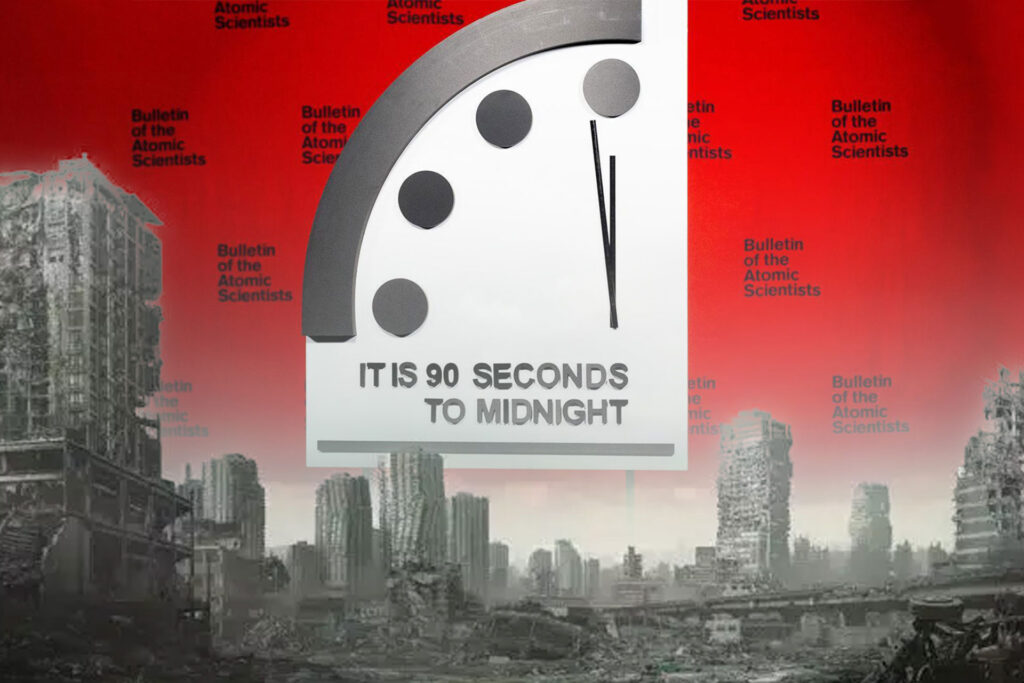The Doomsday Clock, whose supposed hands show the minutes and seconds remaining until the destruction of the world in the apocalypse caused by human activities, is still only 90 seconds away from midnight.
After showing 100 seconds to midnight for three consecutive years, the Doomsday Clock moved forward by 10 seconds for the first time in history last year and increased its distance to midnight to 90 seconds. Representatives of the Bulletin of the Atomic Scientists (BAS) announced on Tuesday that the clock remains at its current critical position this year, largely due to the existential threat posed by climate change and the escalation of nuclear tensions as a result of Russia’s continued invasion of Ukraine.
BAS is a non-profit organization of scientists and political experts who set the time of the doomsday clock. Representatives of this organization also consider destructive technologies such as advanced bio-research and fake news campaigns to be among the dangers that contribute to our movement towards self-destruction.
The time of doomsday is determined by the Science and Security Board of the Atomic Scientists Bulletin (SASB). Herbert Lane, senior researcher at the Center for Security and International Cooperation at Stanford University and a member of this panel told LiveScience: “The Board of Science and Security Bulletin covers many different areas, including a wide range of events or factors related to the possibility of nuclear war, climate change, biological threats such as aliens or biological weapons, and emerging technologies that may disrupt peace and stability. commented.”
The Bulletin of the Atomic Scientists created the Doomsday Clock in 1947 to warn of the existential threat posed by nuclear weapons, initially setting it at seven minutes to midnight. Two years later, after the first successful Soviet atomic bomb test during the Cold War between the United States and the country, the clock struck three minutes to midnight. In 1953, after the explosion of the world’s first hydrogen bombs, the clock was one minute closer to midnight; But again in 1960 it returned to seven minutes to midnight. In 1991, after the collapse of the Soviet Union and the signing of the Strategic Arms Reduction Treaty, which obliged the two superpowers to reduce the number of long-range nuclear weapons, the time difference between the clock and midnight increased to 17 minutes.
The doomsday clock entered the two-minute warning zone in 2018 for the first time since 1960 due to “reckless language in the nuclear realm” and the world being “on the brink of a new arms race,” according to BAS President and CEO Rachel Bronson. Then, during the last 6 years, the clock gradually reduced its distance to midnight.
The decision to move the clock forward last year was largely based on human inaction on climate change and fear of war in Ukraine. However, a host of other factors were also involved. “We’ve been considering disruptive technologies for years, from Internet disinformation to new biological research,” Neal said. This year, the discussion in the field of technology should also include the recent rapid advances in artificial intelligence.
New technologies create their own risks; But they can also exacerbate existing challenges. “We note the risk of corruption in the global information environment acting as a threat multiplier,” Lin said. The mass of misinformation and lies about nuclear threats, climate and globalization make it more difficult to solve these problems; Because it goes against the political consensus needed to deal with them seriously.”


![Galaxy S24 Ultra under the microscope of Zoomit; A strong and resistant Korean monster [تماشا کنید]](https://pcjow.com/wp-content/uploads/2024/01/galaxy-s24-ultra-back-view-black-water-65b2bad6381b5915be4ef1cf-150x150.jpeg)
